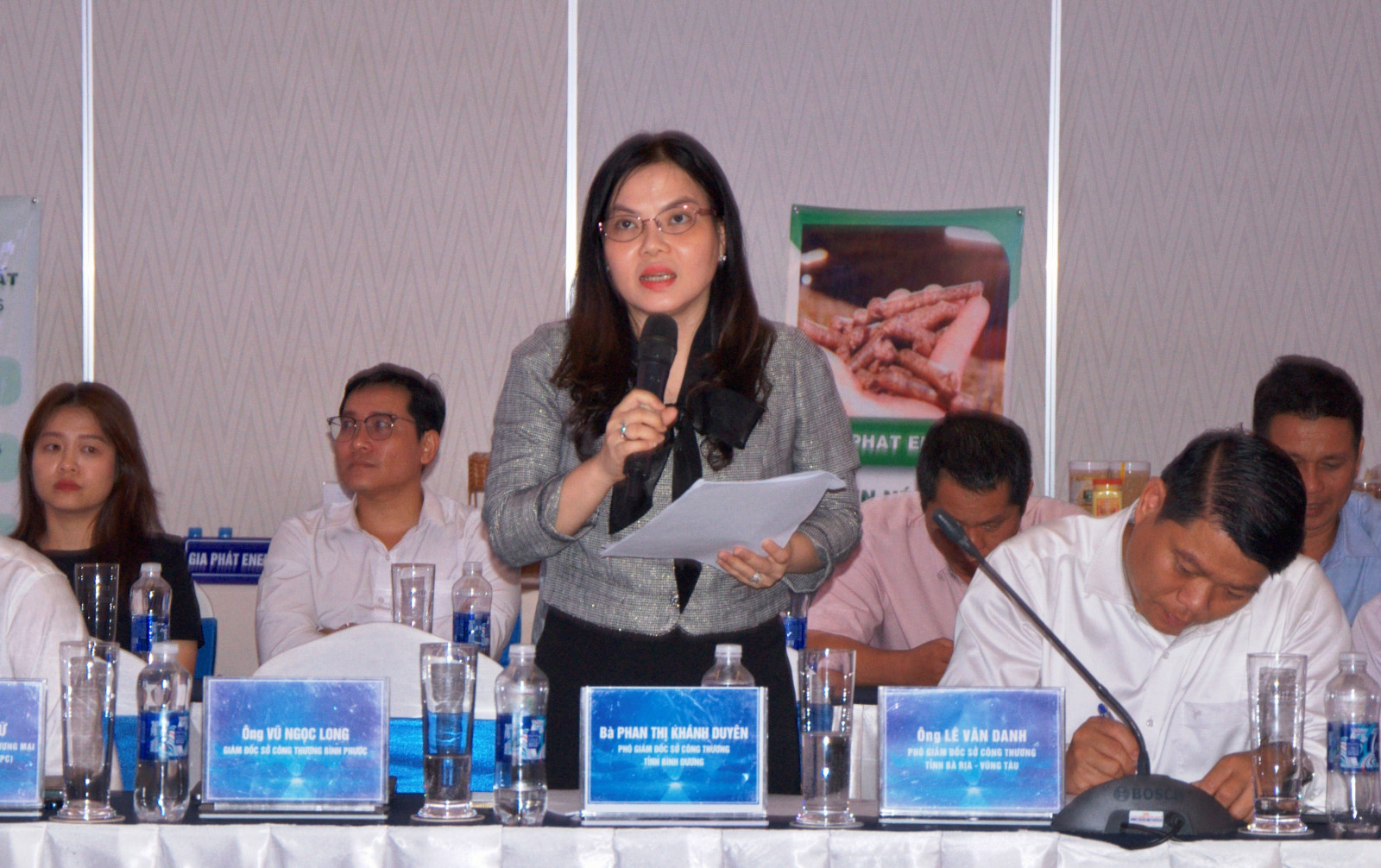Cooperation made to develop import-export in Southeast Region
Southeast region is an economic region with many advantages for production and trade development. To fully exploit the potential and promote effective regional linkages, the Southeast region is focusing on improving transportation infrastructure connectivity, promoting trade, logistics, and enhancing support for small and medium-sized enterprises.

Mrs. Phan Thi Khanh Duyen, Deputy Director of the Department of Industry and Trade of Binh Duong province, shared at the conference on promoting trade and export development in the Southeast region
Efficient tapping
At the conference on trade promotion and export development in the Southeast region on July 31, with the participation of 6 provinces and cities, Deputy Minister of Industry and Trade Phan Thi Thang stated that in order to create a new breakthrough in promoting the important position and effectively exploiting the potential and advantages of the Southeast region, it is necessary to promote science, technology, and value chain linkages in production to enhance the value of products, linking regions in trade promotion and professional-scale import-export activities. To do so, the Southeast region needs to maximize resources and effectively implement breakthrough action programs.
According to the Ministry of Industry and Trade, the import-export turnover of the region in 2023 reached 220.5 billion US dollars. In the first 6 months of 2024 alone, it reached 115.7 billion US dollars, accounting for 31% of the country's import-export turnover. Alongside positive results, according to Deputy Minister Phan Thi Thang, the Southeast region is facing many issues that need to be resolved, including issues such as the region's development speed not matching its potential over time, The contribution of the region to the country's GDP is currently decreasing, while there are still many untapped potentials and advantages.
“Besides, the industry is developing unsustainably, mainly in processing, assembly, and low value-added. The supporting industry is developing slowly; the distribution of export processing zones and industrial zones is not reasonable (the central area still concentrates on industrial zones that require a lot of labor and have low value-added). At the same time, we have not mastered high technology, core technology, and source technology in key sectors," emphasized the Deputy Minister of Industry and Trade.
Mr. Nguyen Van Dung, Vice Chairman of the Ho Chi Minh City People's Committee, shared that Ho Chi Minh City, together with the business community, has been and is coordinating and utilizing natural resources (especially agricultural products, foodstuffs...), free trade agreements (FTA), and existing policies to enhance connectivity and pursue a sustainable green export strategy to create a competitive advantage.
“When provinces and cities in the same region cooperate, they will create a large domestic market, creating conditions for large-scale production enterprises, reducing production costs, and improving product quality. Regional connectivity also helps maximize available resources, share experiences, form efficient supply chains, thereby enhancing the position of regional products in the international market,” Mr. Nguyen Van Dung said.
Connectivity intensified for mutual development
At the conference, Ms. Phan Thi Khanh Duyen, Deputy Director of the Department of Industry and Trade of Binh Duong province, said that there is a reality that needs to be recognized, which is that most products in the Southeast region have not been able to establish their own brands. The main export products are raw exports, exports through intermediaries, or processing for foreign brands. Very few products can be exported under their own brand.
To be able to achieve the objectives of the overall strategy and maintain a high export position, Binh Duong proposes to build a common brand for the Southeast region for 4 key commodities of the region based on the advantages of provinces and localities: Wood, leather shoes, agricultural products, and technological products.
Ms. Phan Thi Khanh Duyen proposes that the region should create internal forces to form a dynamic industrial technology area, attracting investment in the production of electrical and electronic products, IoT products, artificial intelligence, in order to establish a legal framework for the construction and implementation of tasks... to create advantages for the development of the information technology industry. In this regard, evaluate the common and specific points of the localities in developing the information technology industry to link and support each other in appropriate development trends.
Sharing about the development of logistics infrastructure at the local and regional level, Mr. Le Van Danh, Deputy Director of the Department of Industry and Trade of Ba Ria - Vung Tau province, believes that Ba Ria - Vung Tau has long been one of the three important growth poles of the key economic region of the Southeast, and is the gateway to the sea for the southern provinces. In the upcoming period, Ba Ria - Vung Tau province aims to develop the logistics service sector into a high-value-added industry, linking logistics services with the development of production of goods and import-export activities.
“However, the development of a synchronized logistics network requires the support of state agencies in perfecting policies and laws regarding logistics services. This includes mechanisms and outstanding policies to promote the logistics industry and establish large, professional logistics enterprises. Concurrently, it is necessary to research and train specialized human resources to help Vietnamese logistics businesses quickly catch up with other countries, enhance competitiveness, and expand markets both domestically, regionally, and internationally," Mr. Le Van Danh shared.
On May 4, 2024, Prime Minister Pham Minh Chinh signed Decision No. 370/QD-TTg approving the Southeast Region Development Plan for the period 2021-2030, with a vision towards 2050. By 2030, the Southeast region aims to become a civilized and modern area with developed industries, surpassing the high-income threshold and leading the country in terms of material and spiritual life of its people. It will be the largest growth driver in the country, with dynamic and high-speed development. It will also be a center for science, technology, innovation, high-tech industries, logistics, and a highly competitive international financial center in the region.
Reported by Tieu My – Cam Tu – Translated by Vi Bao

